The 1921 census has now been released on Scotland's People. The census is a survey which collects information on every household, building and vessel in Scotland on a particular night. Found amongst the 150,000 images of 4.8 million individual records, are the performers and staff of Lord George Sanger’s Circus who were based in Carnoustie on the evening of Sunday 19th June 1921.;
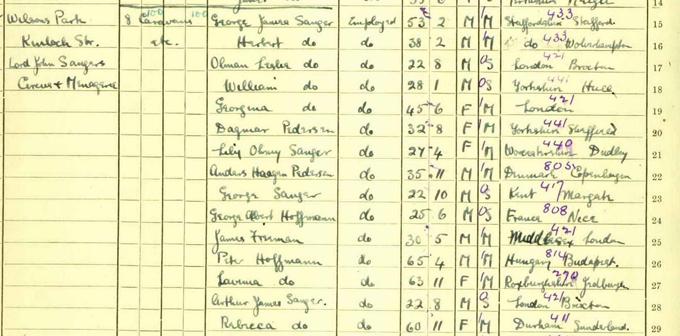
Detail from the first of four pages enumerating members of 'John' Sanger’s Circus. The name of the circus appears to have been called both John and George Sanger's circus at different times.
Crown copyright, National Records of Scotland (NRS), 1921 Census, 274/3/2 page 23
Originally called ‘Circus Sanger’, the company was founded in 1821 by John Sanger (1819-1889), born in Chew Magna, a village in Somerset, England, and his brother ‘Lord’ George Sanger (1827-1911), born in Newbury, Berkshire. The circus had humble beginnings with the purchase of a pony from Croydon for £8, an old grey horse, two cornets and a drum which formed the main entertainment. It was George who later renamed the business as ‘Lord George Sanger’s Circus’. It was later noted in ‘The Music Hall and Theatre Review’, 30th November 1911, that ‘Lord’ George Sanger ‘used to say “I donned my tights the very day Queen Victoria put on the crown”…[and] his ‘title’ arose from the nickname ‘Lord’ being conferred to him because of his gentlemanly manners.’
In 1871, Sanger purchased Astley’s amphitheatre and menagerie for £11,000 (the equivalent today of almost £700,000 according to The National Archive’s currency converter), later running circuses across Britain including Glasgow, Dundee and Aberdeen. It was reported that King Edward VII, when Prince of Wales, attended Astley’s to see ‘the only white elephant in the Western world.’ Sanger later admitted to the prince that the elephant was not naturally white but instead received a coat of whitewash paint twice a day. Sanger also entertained the Prince’s mother, Queen Victoria, in 1899 when she watched his circus from her carriage in the grounds of Windsor Castle.
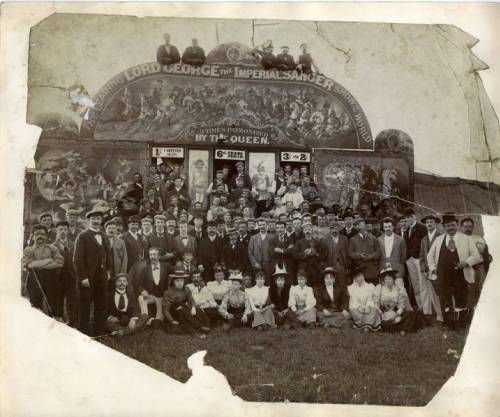
Photograph of circus performers in front of a ticket booth for ‘Lord’ George Sanger’s Circus. The entrance façade has the wording ‘Lord George the Imperial Sanger/The Leading Show of the World/ 3 Times Patrionized by the Queen’ painted on the front.
Reproduced with permission of the University of Sheffield.
'The Music Hall and Theatre Review’ also reported how fearless Sanger was with his animals, working with even ‘the fiercest man-eater imported from the African wild.’ When a lion escaped its cage one evening, Sanger stopped the efforts of local soldiers, who were armed with bayonets, and the fire brigade, who were turning their hose on the animal in the darkness, by walking over to the lion and pulling him to his cage by its ear. Sanger later said that only he knew how frightened the lion was and ‘how glad it would be to get home to its nice warm bed!’
In 1874, Sangers sold all of the equipment needed for producing their show ‘The Congress of Monarchs’ in America to Mr P. T. Barnum, an American showman, businessman and politician. This was a pageant which focused on equestrian events with chariots carrying actors playing rulers from Confucius to Queen Victoria. It ran in New York and Boston throughout the spring and summer of that year.
As well as tremendous success, the circus witnessed tragedies over the course of its lifetime. In 1903, an elephant handler, Joseph Williams, died after he was stabbed in an argument with William Watson who was teasing his performing sheep in Hereford, England. Eight years later, on 28th November 1911, Lord George Sanger (aged 84) was killed by an ex-employee, 28-year-old Herbert Cooper. Cooper was one of the sons of Mr Sanger’s farm bailiff and had been the showman’s personal attendant. He killed Sanger as he sat in his dining room in his home in Finchley, Middlesex, attacking him with a hatchet at 5.40pm. Sanger died ten minutes later from his injuries. The man also attacked two of Sanger’s servants who were in the house, Mr Jackson and Mr Austin.

Lord George Sanger
Credit: The Music Hall and Theatre Review, 30th November 1911. Newspaper image © The British Library Board. With thanks to The British Newspaper Archive
(www.britishnewspaperarchive.co.uk)
Following Sanger’s death, the circus still continued to operate. In 1921, it toured Britain and on 17th June it advertised in the Dundee Evening Telegraph that people should ‘make a point of visiting Sanger’s Circus to-day (Friday) at 2.30 or 8pm or to-morrow (Saturday) 2.30 or 8pm. After Saturday it will be too late to see this delightful show. Positively last 4 performances in Dundee.’ Seats were sold at 5 shillings 9 pence and 3 shillings 6 pence and they would then move to entertain in Carnoustie, Arbroath, Montrose and Laurencekirk before travelling to Aberdeen.
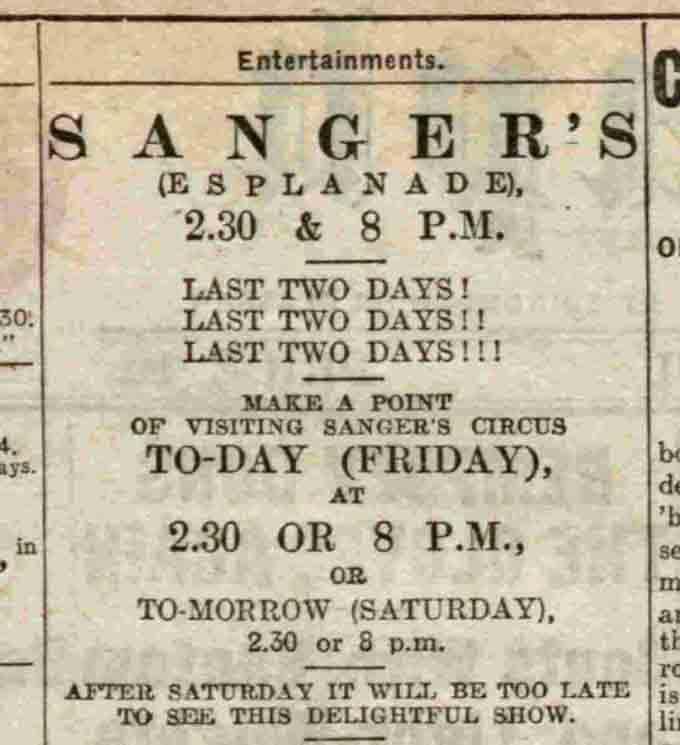
Detail from the advertisement promoting the circus’s tour in Dundee
The Evening Telegraph, Friday 17th June 1921. Courtesy of DC Thomson and the British Newspaper Archive.
On 24th June 1921, the Montrose Standard reported that the circus had celebrated its hundredth birthday ‘in fitting fashion with a show that is little short of superb. Fun was not lacking in the entertainment, and from such a wit as Pimpo [the clown] it was absolutely irresistible… His amusing patter and mirth-provoking antics are never-ceasing. Sensation was provided in plenty, and from such dare-devils as the company includes was hair-raising. Cycling in mid-air is child’s play to the Gerettes…standing upside down on a bicycle balanced on a taut wire 40 feet above the ground….The snake-charmer was there as in the sun-beaten marts of the Orient, and the appearance of three loathsomely-fascinating reptiles sent a delightful cold shiver down one’s back….It must be a matter for wonder to everyone how animals can be trained to such a pitch of perfection as Sanger’s Horses, ponies, elephants, even sea lions all contribute to the entertainment and in doing so they show almost human intelligence.’
The majority of the men and women travelling with the circus were born in England, with others from Lagos, Copenhagen, Nice and Budapest. One man, George Knight, was noted as being born in ‘Midlothian, Edinburgh.’ Knight was an equestrian, trapeze and high wire artiste. He was born around 1894, the son of J Knight, who also used to perform in the same circus, and Mrs Knight who was from a family of Scottish travellers. Despite being noted as being born in Edinburgh, his birth entry has not been located amongst the records on Scotland's People. It is possible that he was born in Edinburgh but then travelled elsewhere with his family where he was registered.
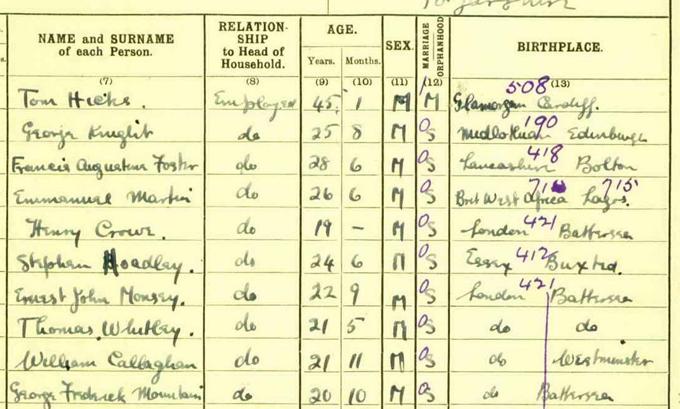
Detail from the 1921 census enumerating George Knight
Crown copyright, NRS, 1921 Census, 274/3/2 page 24
The circus continued until 1941 when, in the midst of the Second World War, the business struggled to obtain enough meat for its carnivorous animals. The Government banned all dangerous animals from public performances; this ban, alongside blackouts, labour shortages and food rationing, forced the company to sell their animals. The circus later regrouped, closing in 1962 in Margate.
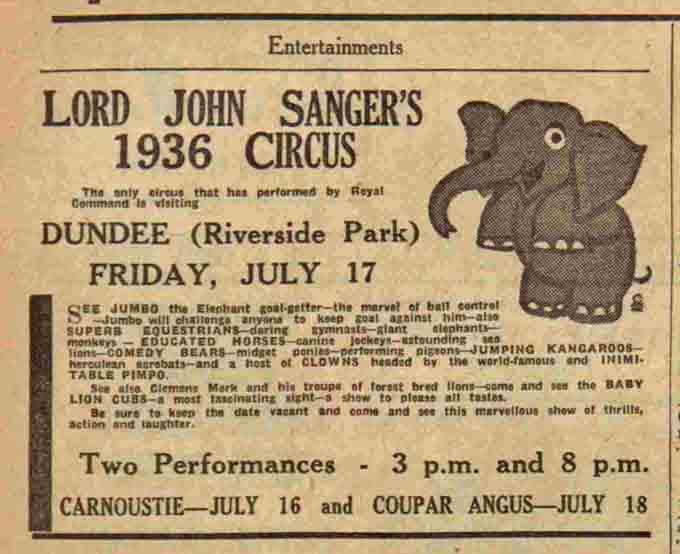
An advert for Lord John Sanger’s Circus in 1936
Credit: The Evening Telegraph, Thursday 16th July 1936. Courtesy of DC Thomson and the British Newspaper Archive.
To find out more about the census records and how to use them for your own research, please see our online guide.
The Sanger Circus collection is held by The University of Sheffield. For more information please visit their website.